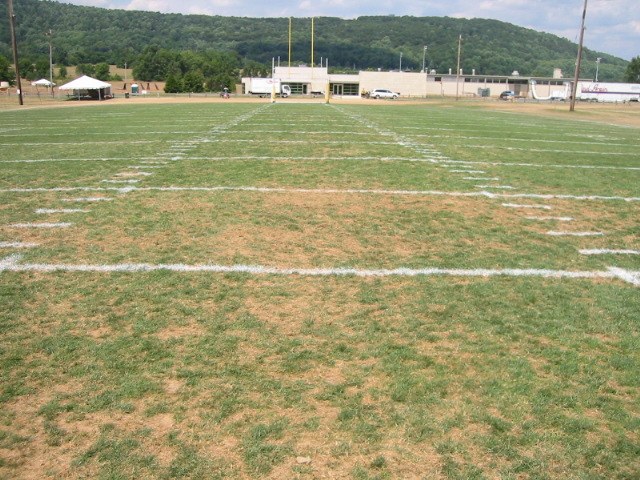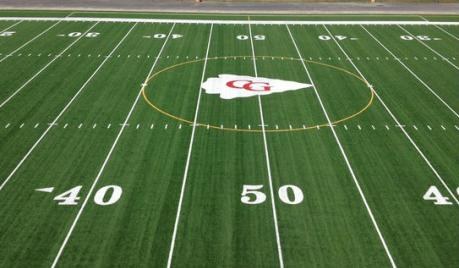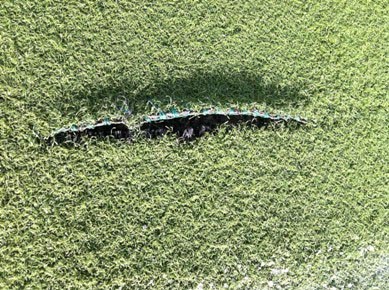Welcome to From the Field - A Guide to Athletic Field Safety and Care
Throughout this series, we will focus on a sometimes overlooked but critical component affecting the safety and performance for athletes of all ages - the playing surface.
Our goal is provide you with simple, helpful tips about playing conditions that maximize both safety and performance
Dealing with Heavily Used Fields

The rigors of football are not only hard on players and coaches but the playing field, too.
Repetitive drills and multiple practices per day during the late summer heat can put a beating on your field before the season even begins.
A few simple tips can help minimize field wear and tear. Read It Here
Preparing Your Natural Grass Field for the Season

Preparation is key for teams to perform at their best. It is no different for your field.
Caring for and preparing your field now will help it perform its best throughout the season. Read It Here
A Checklist for Synthetic Turf Fields - Best Management Practices

A common misconception is that synthetic turf fields are maintenance-free. This is not the case.
Synthetic turf fields require regular maintenance to preserve and enhance safety and playability along with maximizing the turf's lifespan. Read It Here
Getting to Know Today's Synthetic Turf

Once primarily reserved for professional stadiums, synthetic turf fields can now be found in communities across the country.
Whether considering a switch from natural turf or replacing a current synthetic turf field, it is important to know the terminology and understand the characteristics of today's synthetic turf systems. Read It Here
Spring Field Care is Key for Season-Long Success

While the football season may seem like a long way off, proper field care in the spring helps maximize safety and playability in the fall.
There are several important steps to successful spring field care. Read It Here
Field Hardness Impacts Head Injury Risk

Reducing head injuries is a major focus for football leagues across the country.
While concussions can be the result of helmet-to-helmet contact, research reports have shown that approximately 10 percent of concussions in football are casued by the head impacting the surface.
A properly maintained playing surface can help reduce head injury risk. Read It Here
Preparing Your Field for Winter

Late fall field care is an important step in getting your field ready for next season.
If you field is as heavily-used as most, there likely is plenty of thin turf and even some bare ground on your field.
While temperature may be cool and sunlight is limited, there still is a benefit to late season field maintenance. Read It Here
Proper Synthetic Turf Maintenance Maximizes Player Safety and Performance

A common misconception is that synthetic turf fields are maintenance-free.
While routine mowing, fertilization and other upkeep required on natural turf fields are not needed on synthetic turf fields, other types of maintenance are required to preserve and enhance the safety, playability and lifespan of these fields.
If a field is not properly cared for, problems can develop, such as low and inconsistent infill levels, separated seams, degrading fibers and surface debris. These problems can create hazards and accelerate field aging.
The good news is that by following a few field maintenance guidelines, you can help protect the athletes using your field and also your investment.
Seeding for Success

As we turn the page on summer and head into fall, it is finally time for some football.
Hopefully, your season is off to a great start and you have a couple of games in the win column. With some games in the books, there is a good chance that your field may not look as good as it did just a few short weeks ago.
During the course of the football season, the wear and tear of games and practices can significantly wear out your field.
Heavy-use areas, such as the center of the field, often wear out quickly and without proper maintenance can be reduced to nearly bare ground by the end of the season. Read It Here
How to conduct a proper pregame field inspection

With everything involved in preparing for a football game, inspecting your field may not be No. 1 on your pregame priority list. However, routine field inspections can reduce injury risk by identifying and correcting potential hazards before the players hit the field.
The NFL now mandates that fields be inspected prior to all games with each field manager required to submit an official report following the inspection.
This month's column will guide you through the field inspection process and provide other tips to help reduce potential field hazards. Read It Here
Mowing and fertilizing your way to a better field

Mowing and fertilizing are two of the most basic components of managing grass football fields.
On the surface, these maintenance practices seem simple enough - mow to keep the grass short and fertilize to make it grow.
But, with proper knowhow, these seemingly simple tasks can be utilized to produce a field that both looks good and maximizes athlete safety. Read It Here
Synthetic turf and human health - What does the research say?

Synthetic turf has come a long way since it was first installed in 1966 in the Houston Astrodome.
The current generation of synthetic turf - known as infilled synthetic turf because of the crumb rubber infill used in its construction - can be found in hundreds of communities throughout the United States.
This edition of From the Field highlights studies examining potential health impacts related to infilled synthetic turf. Read It Here
Paint like a pro

Painting a football field is not a simple, quick task.
Proper field markings are necessary components of the playing surface, and a well-lined field can be a source of pride for coaches, players and fans.
Using proper painting techniques and the right materials will prevent turf damage and result in a more consistent, safe surface. Additionally, easy-to-see field markings will alert players of sidelines and end lines and reduce the risk of colliding with obstacles outside the field of play. Read It Here
Proper shoes are the biggest ingredient to good traction

A certain level of traction is required for running, changing direction and other movements on a football field.
But is there such a thing as too much traction? And, if so, what roles do shoes and the field surface play?
Most researchers and medical professionals agree that too much traction can exist. Specifically, rotational traction has been linked to risk of injury to knees, ankles and other parts of the lower extremities. Read It Here

